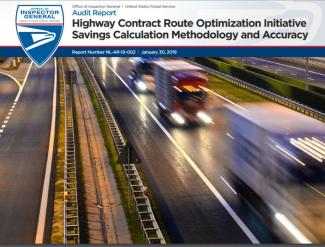Highway Contract Route Optimization Initiative Savings Calculation Methodology and Accuracy
Objective
Our objective was to evaluate the Postal Service’s Highway Contract Route (HCR) Optimization Cost Savings methodology and the accuracy of reported savings for fiscal year (FY) 2017.
The Postal Service implemented the Zero Base HCR initiative in FY 2014 (renamed HCR Optimization in FY 2017) to reduce surface transportation costs by identifying, adjusting, and eliminating unnecessary HCR trips.
The Postal Service Vice President, Network Operations, sets the HCR cost-reduction goal annually based on total HCR costs. The annual savings goal of about $44.4 million for FY 2017 was allocated to each Postal Service area based on area HCR mileage. The headquarters Surface Transportation Operations (STO) group relies on area Network Operations managers and local administrative officials to review and adjust HCR trips to reduce costs and achieve planned savings goals. Administrative officials submit service change requests for HCR trip adjustments and the STO specialist calculates net quarterly savings for finalized service change requests and terminated routes.
We judgmentally selected two of the seven Postal Service areas (Pacific and Capital Metro) with the highest and the lowest ratios of reported to planned savings in FY 2017. We then selected six mail processing facilities from these two areas based on route utilization percentages to review underutilized trips. The six facilities were the Los Angeles and San Francisco Processing and Distribution Centers (P&DC) and the Los Angeles Network Distribution Center (NDC) in the Pacific Area; and the Southern Maryland P&DC, Atlanta NDC, and Capital Metro Surface Transfer Center in the Capital Metro Area. We also reviewed the nationwide savings calculated by the STO specialist for FY 2017.
The Postal Service reported savings of about $67 million in FY 2017, exceeding its planned savings goal by about $22 million.
What the OIG Found
We determined the methodology used to calculate the HCR optimization cost savings was not documented and was inconsistently followed and inadequate. Furthermore, there were no nationwide cost savings from the HCR Optimization Initiative in FY 2017.
We reviewed and analyzed the FY 2017 HCR savings methodology, calculations, and the service change requests and HCR contract termination data files. We compared the results to the Postal Service’s reported savings and found that the methodology the Postal Service used for the savings calculations included errors, overstating reported savings by about $119 million and understating them by about $37 million, resulting in a net overstatement of about $82 million. Specifically, we found that the reported savings calculations:
- Excluded 8,819 of 9,100 (or about 97 percent) service change requests, which resulted in a net overstatement of about $82 million. For example, service change requests for eliminated and added trips for operational needs were not always included in the savings calculation, as required.
- Included 104 terminated routes and 31 service change requests subject to exclusion rules, which resulted in a net overstatement of about $24 million and $12 million, respectively. For example, service change requests and terminated routes related to Dynamic Route Optimization should be excluded from the HCR savings calculation because the savings are reported separately.
- Excluded 763 of the 930 (or about 82 percent) terminated routes which should have been included in the savings, resulting in an understatement of about $36 million.
- Inaccurately calculated savings for 56 service change requests, which resulted in a net understatement of about $800,000.
This occurred due to lack of standard operating procedures for the HCR savings calculation methodology; lack of requirements for updating the savings calculation for pending renewals/awards; and service change requests that were not previously captured due to timing differences, inconsistent application of the methodology, and insufficient validation of the calculated savings.
What the OIG Recommended
We recommended management reevaluate the continuation of the Highway Contract Route optimization cost savings calculation; and, if the program is continued, develop standard operating procedures and automate the methodology for calculating and validating the savings calculation to account for the timing differences, ensure consistent application, and avoid manual calculation errors.

